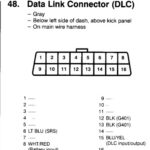The 1992 Honda Accord sits at a transition point in automotive diagnostic technology. Determining whether your 1992 Accord uses OBD1 or OBD2 is crucial for proper diagnostics and repairs. This guide will clarify which system your vehicle utilizes and how to retrieve diagnostic trouble codes (DTCs).
Identifying Your Accord’s OBD System
While 1996 is widely recognized as the year OBD2 became mandatory in the United States, some manufacturers, including Honda, introduced OBD2 systems earlier. Most 1992 Honda Accords utilize the OBD1 system. However, certain models, particularly those sold in California, may have been equipped with an early version of OBD2.
The most reliable method to confirm your Accord’s system is to visually inspect the under-hood diagnostic connector.
-
OBD1: Typically a blue, two-wire connector located near the passenger side kick panel. It may also be found under the driver’s side dashboard.
-
OBD2: A 16-pin connector, usually located under the driver’s side dashboard.
Retrieving Diagnostic Trouble Codes (DTCs)
OBD1: Reading Flash Codes
If your Accord has a two-wire connector (OBD1), you can retrieve codes using the following method:
- Jump the Connector: Use a paperclip or jumper wire to connect the two terminals within the diagnostic connector.
- Turn Ignition to “ON”: Turn the ignition key to the “ON” position without starting the engine. All dashboard lights should illuminate.
- Observe the Check Engine Light (CEL): The CEL will begin to flash a series of long and short blinks. Each series represents a DTC. A long blink equals 10, and a short blink equals 1. For example, one long blink followed by two short blinks indicates code 12.
- Record the Codes: Write down the sequence of flashes. The codes will repeat after a short pause.
- Consult a Code List: Use the following table or consult a repair manual to decipher the meaning of each code:
| Code | Description |
|---|---|
| 1 | O2A – Oxygen sensor #1 |
| 2 | O2B – Oxygen sensor #2 |
| 3 | MAP – Manifold Absolute Pressure Sensor |
| … | … |
| 92 | Evaporative Emission Control System Insufficient Purge Flow |
Note: This table is not exhaustive. Refer to a comprehensive OBD1 code list for your specific 1992 Honda Accord model. Some codes may vary depending on engine and transmission type.
OBD2: Using a Code Reader
If your Accord utilizes the 16-pin OBD2 connector, you will need an OBD2 code reader to retrieve DTCs. These are readily available at auto parts stores. Follow the instructions provided with your code reader.
Resetting the ECU
After addressing the issues indicated by the DTCs, you may need to reset the Engine Control Unit (ECU). This process varies slightly between OBD1 and OBD2. However, a common method for resetting the ECU in a 1992 Honda Accord involves disconnecting the negative battery terminal for several minutes. Consult your vehicle’s repair manual for the recommended procedure.
Conclusion
Correctly identifying whether your 1992 Honda Accord uses OBD1 or OBD2 is the first step in diagnosing and resolving any engine issues. By using the information provided in this guide, you can accurately retrieve trouble codes and begin the repair process. Remember to consult a repair manual specific to your model for detailed diagnostic and repair procedures.
